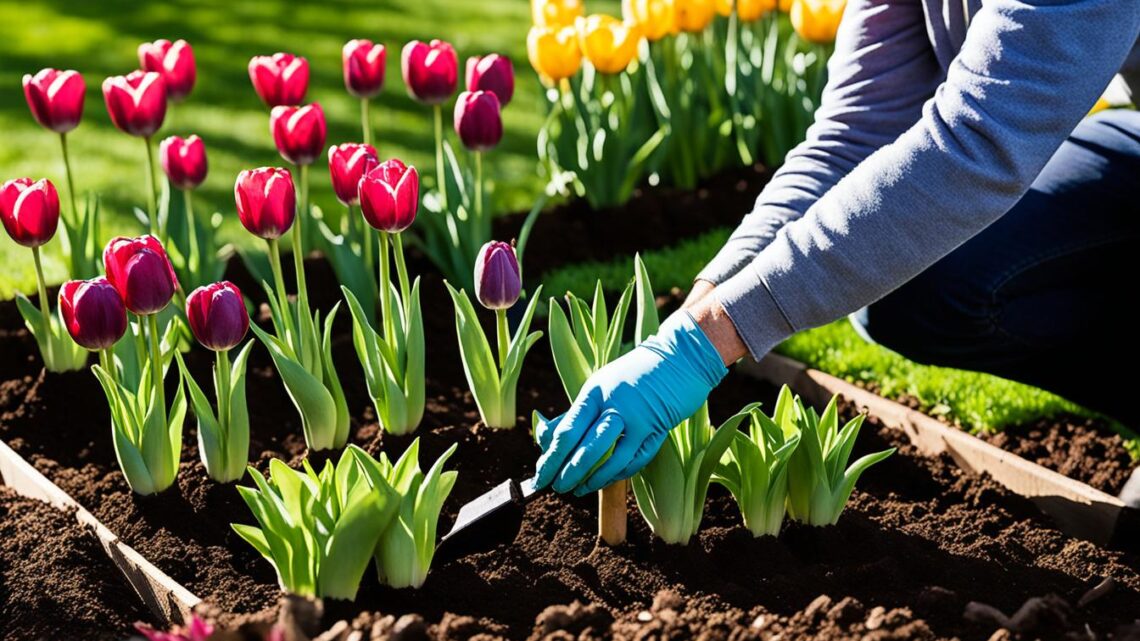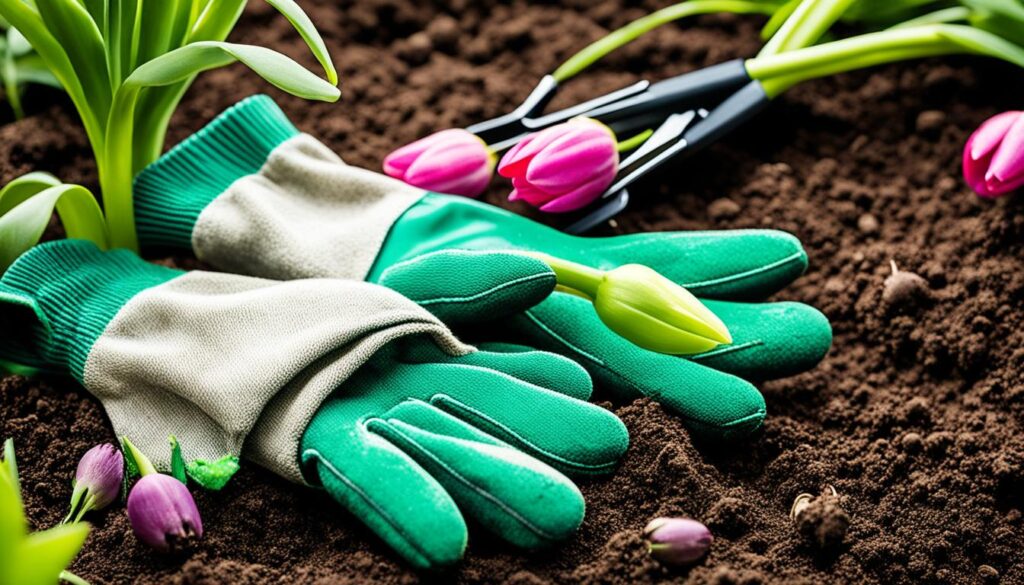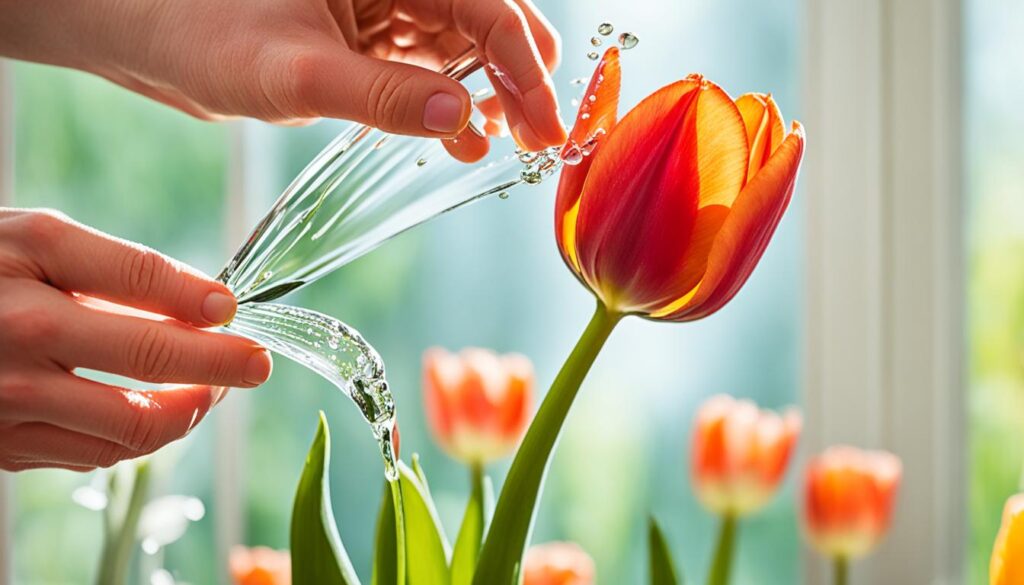
Ready to make your garden burst with color this spring? Then tulips are the perfect choice. They are the stars of spring. They’re stunning, but growing them well might mystify you. This guide will show you how to plant them for years of beautiful blossoms.
Tulips are among the most loved spring flowers. They come in many colors and shapes, making the garden look elegant. No matter your gardening skill, this guide has what you need. You’ll get expert tips and techniques for planting tulips. This means your garden will have lovely perennial blooms every spring.
About Tulips
Tulips are colorful flowers that show up in late winter or spring. They stand tall with each bulb making just one flower. The flowers grow on stems without leaves.
Bloom Time and Growth Habits
In a garden, tulips offer many shapes, sizes, and colors from early to late spring. They bloom for weeks, making spring bright and beautiful. This long blooming time creates a sea of colors.
Tulip Types and Varieties
There are various tulip types such as single, double, and lily-shaped. Diverse varieties like ruffled and fringed offer options for different gardens. Gardeners can choose from many types to make their garden stunning.
Are Tulips Annual or Perennial Bulbs?
Tulips are usually thought of as annuals in North America. This is because they don’t come back every year reliably. Yet, in places like the western U.S., they might come back better. These areas have a climate that’s like where tulips originally come from.
To make tulips last longer, gardeners can split the bulbs every few years. This helps provide more room for them to grow. By doing this, the tulips may bloom year after year.
Choosing the Right Planting Site
Finding the best spot is key for your tulips to grow and flourish. These bright plants need soil that drains well and is rich. It’s best to pick a spot with just the right amount of sunlight and some shield from strong winds. This creates the ideal home for your tulips.
Soil Requirements
For the best start, tulips like soil that drains easily and is full of nutrients. Adding compost or other organic material helps with this. It also makes sure the soil has what your tulips need most. Tulips do best in soil that’s a bit acidic, not too basic.
Sun Exposure
Tulips love the sunshine, but some can also thrive in partially shaded areas. They must get at least 6 hours of sun every day. For those in hot areas, some afternoon shade can keep them from drying out.
Wind Protection
Tall tulip types can get hurt by strong winds. Planting them where they’re shielded by natural barriers, like fences or big bushes, helps. This keeps the flowers safe and looking their best.
When to Plant Tulips
You must plant tulips at the right time for a beautiful spring show. This means in the fall, about 6 to 8 weeks before soil freezes. By doing this, the tulip bulbs get enough time to grow strong roots. They’re then ready to burst into our lives with their lovely spring blooms.
Planting Times by Climate Zone
In areas where it’s cooler, like the northern climates, it’s best to plant tulips in September or October. Yet, in warmer spots, such as the southern regions, wait until December or even later. The tulips need a cold period (about 12 weeks) to start growing and blooming.
Pre-chilling Bulbs for Warm Climates
If you’re in a place with warm winters, there’s a trick to help tulips bloom. You can chill the bulbs in your fridge before planting. This will give them the cold they need for those beautiful spring blooms.

How to Plant Tulip Bulbs
Planting tulip bulbs right ensures a beautiful and lasting garden display. You’ll learn everything, from the right tulip planting depth to deterring pests, making your tulips thrive.
Planting Depth and Spacing
Place tulip bulbs 8 inches deep, about three times their size. This keeps them safe from changing temps and promotes strong root growth. Plant them with 4 to 6 inches of space between to grow well without crowding.
Preparing the Soil
Start by loosening the soil to 12 to 15 inches deep. Add a 2- to 4-inch layer of compost or organic matter. This step, known as tulip soil preparation, aids drainage and gives the bulbs a nutrient-rich start.
Deterring Pests and Rodents
Protect tulip bulbs from pests by using thorny leaves or similar tulip pest deterrents. For tulip rodent protection, consider placing wire cages around your bulbs.
tulips planting
Tulips can grow in garden beds or containers, based on your choice and space. For garden beds, find soil that drains well and gets plenty of sun. Plant bulbs 4 to 6 inches apart about 8 inches deep.
Planting in Garden Beds
To plant tulips in garden beds, find a place with the right soil and sunlight. Make sure the soil drains well. You should space the tulip bulbs 4 to 6 inches apart.
Then, plant them deep, around 8 inches. This lets the bulbs stay warm and grow strong roots.
Planting in Containers
If planting in containers or pots, pick ones with holes for water to drain out. Use potting mix that drains well. Space the tulip bulbs 3 to 4 inches apart and plant them 5 to 7 inches deep.
Keep the pots in sunlight. In very cold weather, move them somewhere sheltered inside to keep the bulbs from freezing.

Caring for Tulips After Planting
After you plant your tulip bulbs, they need the right care. This ensures they bloom nicely in the spring. You need to water them and trim the dead flowers to keep them healthy.
Watering Requirements
Start by watering the tulip bulbs well after you plant them. They start to grow roots. In the spring, if it’s dry, they might need more water. But usually, rain is enough for them.
Fertilizing
Fertilize your tulips twice a year. Do this in the fall when you first plant them. Then again in the spring, just before they start growing. A slow-release fertilizer will give them all they need.
Deadheading and Foliage Care
Remove the dead tulip flowers after they’re done. This stops them from using energy to make seeds. The bulbs can then focus on next year’s flowers. Let the leaves brown and dry out on their own. This helps the bulbs get ready for their resting time.
In the summer, tulips don’t need to do anything. You can dig up the bulbs and keep them in a cool place until fall. Then, you plant them again. This keeps your garden full of beautiful tulips each year.
Special Planting Techniques
Elevate your tulip garden with special planting techniques for stunning displays. Whether for mass planting or cut flowers, these methods will turn your space into a colorful tulip haven.
Mass Planting for Impact
Want your tulips to really stand out? Try mass planting in large groups or drifts. First, dig a single circular hole that’s 6 inches deep. Fill it with a mix of organic matter and compost. Then, plant your tulip bulbs close together. This method creates a big, colorful scene that catches everyone’s eye.
Growing Tulips for Cut Flowers
Tulips are great for making indoor arrangements. To produce tulips for cutting, plant bulbs in a long, shallow trench. They should be 6 inches deep and not touching. Add extra water and fertilizer to help them grow strong. When cutting tulips, pick ones with buds just about to open. Keep some leaves on the stem. This step makes your tulips last longer in a vase.
Tulip Pests and Diseases
Tulips are lovely flowers, but they face many risks from pests and diseases. It’s important to know how to protect them. This helps keep your tulip garden beautiful and healthy.
Common Pests and Control Methods
Among the top tulip pests are aphids, thrips, bulb mites, rodents, and deer. You can fight these pests in several ways. For aphids, pick them off by hand. Use ladybugs and lacewings to eat thrips. Scare off rodents with cayenne pepper or human hair. To keep deer away, put up a fence.
Fungal Diseases and Prevention
Tulips can get sick from fungi, causing problems like tulip fire and grey bulb. Look for sick tulip bulbs and get rid of them. Good airflow around plants can help prevent these fungal diseases.
Viral Diseases and Management
Viruses can make tulip flowers look odd. The key to beating viral diseases is to control aphid and thrip numbers. These insects can spread the viruses.
Harvesting and Enjoying Tulips
Tulips are great as cut flowers. This lets gardeners take their beauty inside. When cutting tulips, do it just before the buds open fully. Leave some leaves and cut the stems at an angle. Then, keep them in water, turning the vase each day. This helps the tulips stay fresh and stand tall.
To make cut tulips last up to 7 days, change the water every day. You can also make them last longer by conditioning the stems. Wrap them in wet newspaper for 1 to 2 hours before arranging them. This will give you beautiful tulip bouquets.

Tulip Folklore and Symbolism
Tulips have a deep history and cultural importance. Their name comes from the Turkish word «tülbent,» which means «turban.» This is because they resemble a turban. During the 17th century in Holland, tulip mania was so wild that one bulb could cost more than a house.
Each color of tulip has its own meaning. For example, red tulips show love. The many colors and types of tulips have inspired lots of stories and beliefs. People have admired tulips for their beauty and the feelings they bring out for a long time. Tulips are found in art, literature, and traditions worldwide.
Tulips began in the Anatolian area. They have since spread and become popular all over. They attract gardeners and fans with their beauty and meaning. Dive into the world of tulip stories to understand their cultural importance.



